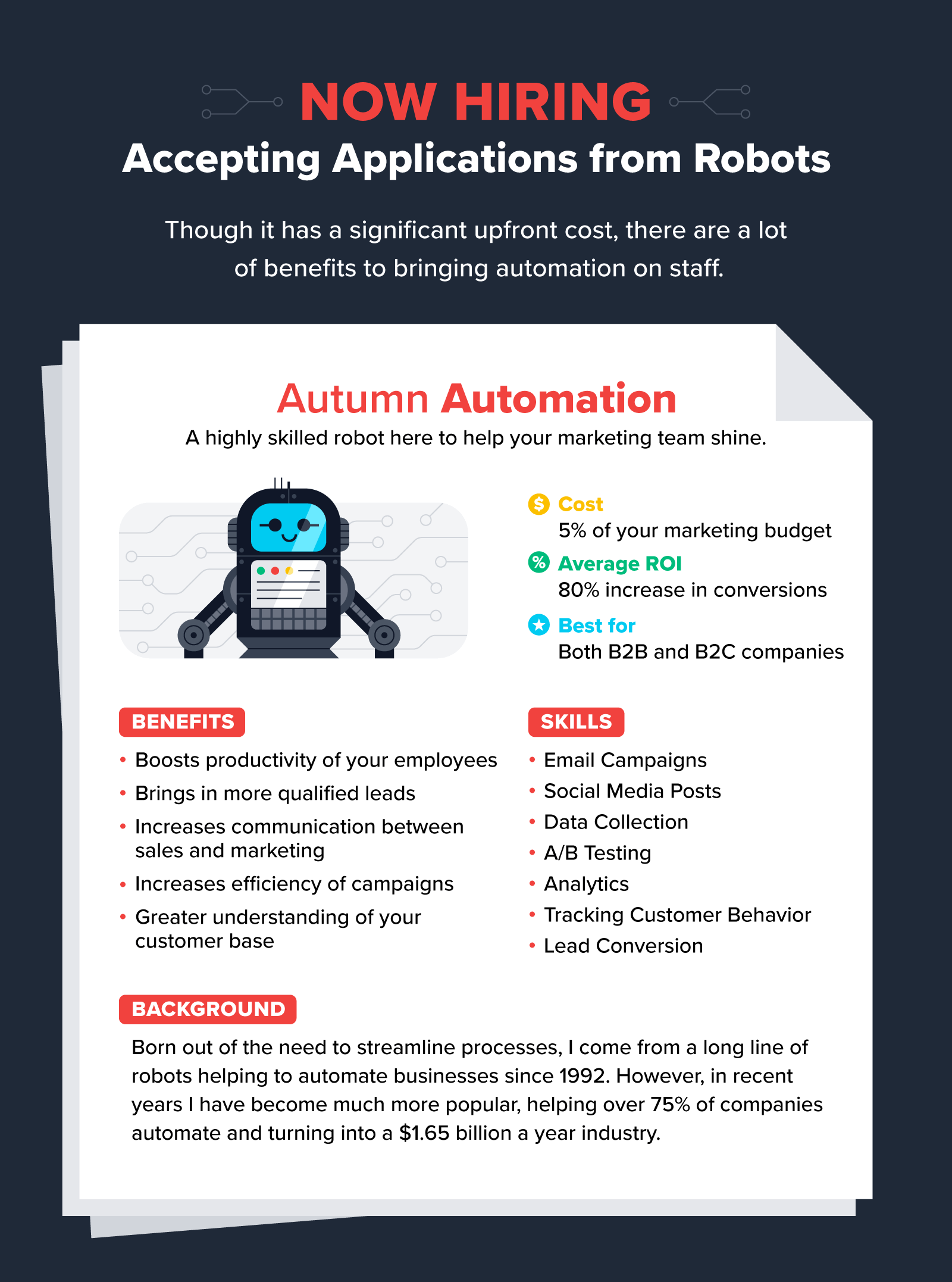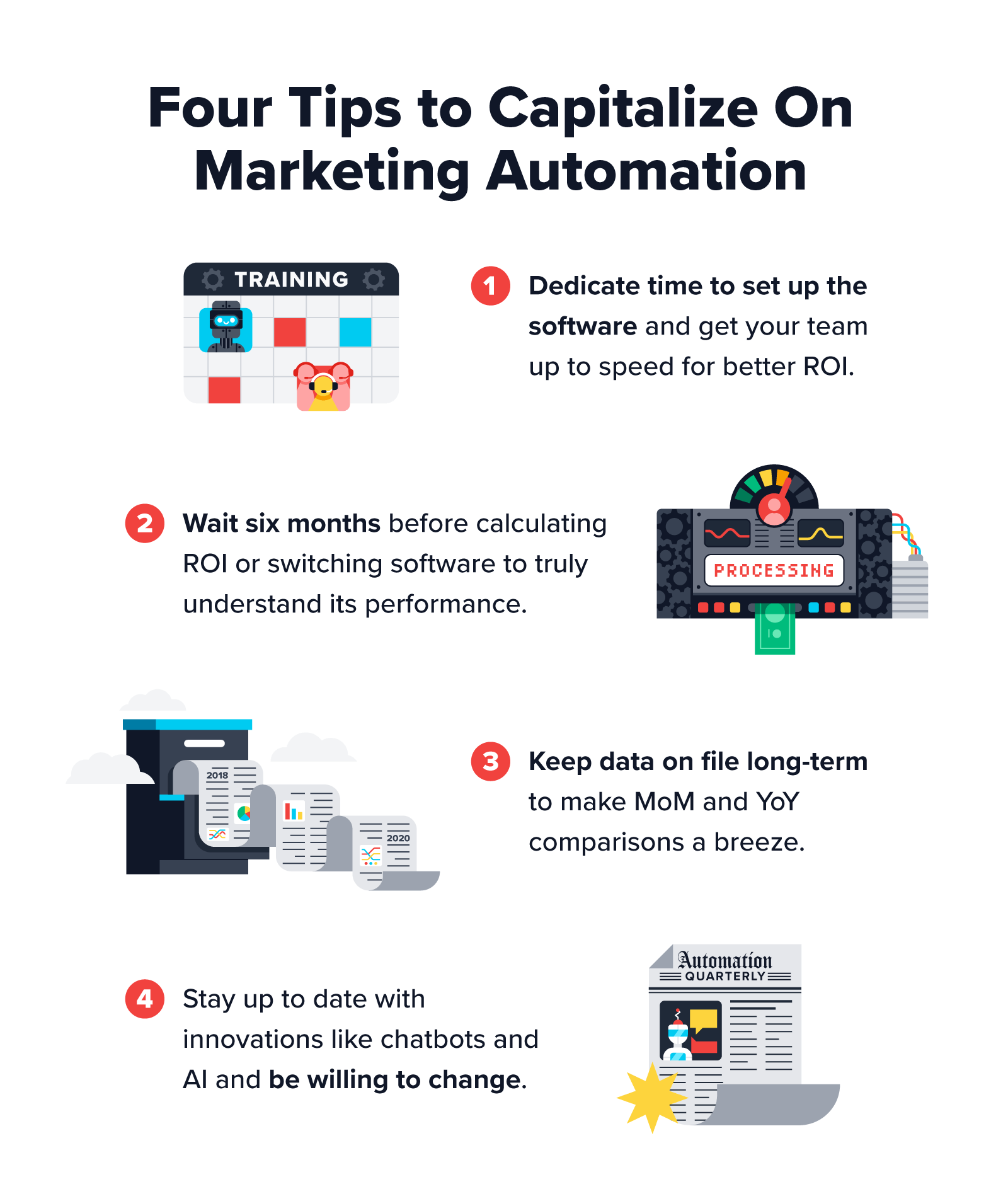Your marketing team works hard to expand your customer base and bring your sales team qualified leads.
But when they have to dedicate a majority of their time to smaller tasks such as scheduling emails or pulling data, it begs the question: is that really the best use of their time?
Marketing automation helps your team get back to working on what really matters — bringing in traffic that converts. By using automation to take over day-to-day tasks, your world-class marketers will be able to dedicate more time to things like innovation and expansion.
So what exactly is marketing automation, and how will it help increase your company’s ROI? We’ll answer all those questions and more with our guide to marketing automation ROI below.
What Is Marketing Automation?
Marketing automation is the process of using software and other automated technology to streamline every part of the marketing process, from sending email campaigns to accessing and analyzing data.
This automation not only helps marketing teams work smarter and faster — but also allows them to get to know their customers on a deeper level (and reduce the dreaded churn).
In addition, sales and marketing teams are able to use these automation tools to work together more effectively and convert a greater portion of their audience into paying customers — the ultimate goal for any company!
But marketing automation isn’t a one-and-done solution to your customer retention woes. As mentioned in our guide to mobile marketing automation, how you use a tool is just as important as the tool itself.
Consider the Inputs
When determining what type of marketing automation is best for your company, it’s a good idea to consider the inputs currently driving your marketing efforts.
Typical inputs include people, time, money, and ideas. Ask yourself the following questions to help figure out where marketing automation will best fit within your current framework:
- How can we automate these inputs to save time and money?
- What current tasks can be automated to free up our worker’s time?
- How can technology streamline the ideation and conversion process?
- How much do these automation services cost and how much are we currently spending on marketing?
- What are the knowledge gaps in our sales and marketing teams?
- What do we not know about our customer base that could help boost ROI?
- What type of marketing takes up the majority of our team’s time?
- Which campaigns and platforms bring in the highest ROI?
Once you understand how your marketing team works (and its challenges), you’ll be better prepared to find automation software that best fits their needs.
What Is the Value of Marketing Automation?
So, what kind of problems can marketing automation solve for your team?
Whether you have a team strapped for bandwidth, a lack of usable customer data, issues with testing, or a problem with conversion, there’s automation software available to help you solve whatever problem you’ve got.
Take ProgrammingHub, for example. This e-learning company was having trouble increasing its subscription base. By working with an automation software company (hint: us) they were able to increase their subscription ROI by 15% using automated campaigns.
That’s the beauty of automation. No matter what your marketing goals are, you can see that ROI percentage skyrocket without undue effort.
How Effective Is Marketing Automation?
Given that 75% of all companies use some sort of automated marketing, it’s a safe bet that the process is indeed effective. However, we know that what marketing and sales teams really care about is data.*
Back up your push for marketing automation by referencing the statistics below on how this process can boost ROI.
- Marketing automation boosts business productivity by 20%*
- Using automation can lead to a little over 14% increase in sales productivity and 12% reduction in marketing costs.*
- 39% of marketers say that automation has increased efficiency by 15% to 35%.*
- The main benefits of automation include increased efficiency and effectiveness of sales and marketing activities.*
- Companies that use marketing automation saw a huge increase in leads and conversions, at 80% and 70%, respectively.*
- According to marketers, some of the most important characteristics of marketing automation platforms are integrations, scalability, and ease of use.*
How It Affects Your Sales and Marketing Teams
Marketing and sales go hand in hand. Just as marketing helps to bring in qualified leads to the sales team, sales, in turn, communicates conversions with the marketing team to help them better understand what campaigns are successful.
But when there are cracks in the communication workflow between these two teams, your company’s bottom line will suffer the consequences.
Automation works to smooth over the cracks by minimizing the workload of both teams, providing real-time analytics and a greater understanding of what it takes to be successful.
Add to that a hefty ROI boost, and automation is a no-brainer for companies looking to take their sales to the next level.
Marketing Automation Costs
You may be wondering how much marketing automation costs. Answer: typically about 5% of your marketing budget.
However, this cost will vary depending on the type of software you use, the add-ons you choose to include, and how big your marketing team is.
Before you sign with the cheapest option to save your company some cash, you should know that you get what you pay for. Many software solutions charge an initial fee for setup followed by monthly fees because their services are worth it — meaning they know you’ll make a return on your investment.
Calculating the ROI of Marketing Automation
To calculate your marketing automation ROI, subtract your marketing cost from your sales growth. Then, take that number and divide it by your marketing cost to determine what return you’re getting on your marketing investment.
The benefits of marketing can be tricky to track, so using this formula allows you to show the direct benefit of your marketing efforts and convince upper-level management to continue to invest in automated services.
Capitalizing on Marketing Automation Long-Term
Typically, automation services provide a better ROI the longer you use them. This is due to the fact that it gives your marketing teams more time to learn the ins and outs of the tool.
In addition, the longer you use the service, the more data you have to analyze to make smarter business decisions.
To learn more about how to capitalize on your marketing automation services to serve you long-term, check out the tips below.
- Dedicate plenty of time and workforce resources to setting up the automation software properly, including in-depth training for your team.
- Give your software at least six months in use before calculating your ROI and considering other options.
Keep all your customer data on file so that you can make month-over-month (and year-over-year) comparisons to learn what’s working and what’s not.
What Is the Future of Marketing Automation?
The future of marketing automation can be defined in two words: growth and anticipation.
As mentioned above, automation is a fast-growing industry. Companies have seen how much time it can save their employees all while increasing their ROI, so you can bet more and more companies will be hopping on the automation bandwagon in the months and years to come.
And while current-day automation is already pretty personalized, in the future marketing automation will go even further by anticipating customers’ needs before they’re even expressed.
This will be shown through customized trigger campaigns, chatbots that answer questions before they’re asked, and integration of AI from top to bottom.
Of course, at the end of the day, your software is only as good as the people behind the scenes. But, with the right tools and a fully trained team, your company can reach new heights with marketing automation integration.
To work with a company that understands the ins and outs of your marketing needs, ask us for a demo to learn all about our campaign optimization process.

Subharun Mukherjee 
Heads Cross-Functional Marketing.Expert in SaaS Product Marketing, CX & GTM strategies.
Free Customer Engagement Guides
Join our newsletter for actionable tips and proven strategies to grow your business and engage your customers.














































